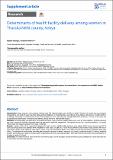| dc.contributor.author | Gezahegn, Takele | |
| dc.contributor.author | Birhanu, Zewdie | |
| dc.contributor.author | Aman, Mamusha | |
| dc.contributor.author | Dessalegn, Muluken | |
| dc.contributor.author | Abera, Asmamaw | |
| dc.contributor.author | Nyagero, Josephat | |
| dc.date.accessioned | 2021-08-24T13:39:30Z | |
| dc.date.available | 2021-08-24T13:39:30Z | |
| dc.date.issued | 11/26/2016 | |
| dc.identifier.citation | The Pan African Medical Journal. 2016;25 (Supp 2):9. | en_US |
| dc.identifier.issn | 1937-8688 | |
| dc.identifier.uri | http://repository.amref.org/handle/123456789/131 | |
| dc.description | © Eliphas Gitonga et al. The Pan African Medical Journal - ISSN 1937-8688. This is an Open Access article distributed under the terms of the Creative Commons Attribution License (http://creativecommons.org/licenses/by/2.0), which permits unrestricted use, distribution, and reproduction in any medium, provided the original work
is properly cited. | en_US |
| dc.description.abstract | Introduction: Kenya records a high maternal mortality ratio 362 maternal deaths per 100 000 live births. Tharaka Sub County has poor transport
infrastructure, low levels of socio-economic status and long distances to health facilities. Secondary to these factors, delivering in a health facility is
a challenge. Delivering in a health facility is one of the strategies to avert maternal death through skilled birth attendance. The aim of the study was
to evaluate the determinants of health facility delivery among women in Tharaka Nithi County.
Methods: the study design was descriptive cross sectional survey. Semi structured questionnaires were used for data collection. Stratified sampling
was used to select the facilities. Systematic sampling was used to select the respondents. The sample size was 345. Descriptive statistics, chi square,
Fishers exact and logistic regression were used in analysis.
Results: majority (79%) of the respondents delivered in health facilities. Health facility deliveries were highest (80%) among women aged 20-34
years and among those who attended level 4 facilities for ante natal care (88.3%). Health facility deliveries were lowest among women with five or
more births. Health facility deliveries were higher among those who attended at least 4 ante natal visits (87.2%) and having individual birth plans
(90%). The likelihood of health facility deliveries was increased by increase in level of education (1.6 times), household income (2.4 times), attending
a higher level facility ante natally (1.4 times), birth preparedness (3 times), attending at least 4 ante natal visits (2.9 times) but was decreased by an
increase in parity (0.5 times).
Conclusion: the determinants of place of delivery are maternal age, level of education, household income, parity, attendance of ante natal care four
or more times and birth preparedness. | en_US |
| dc.description.sponsorship | African Medical Research Foundation | en_US |
| dc.language.iso | en | en_US |
| dc.publisher | Pan African Medical Journal | en_US |
| dc.relation.ispartofseries | Strengthening Health Systems in Communities: The Experiences of AMREF Health Africa;Supp. 2: 9 | |
| dc.subject | Health facility delivery | en_US |
| dc.subject | Maternal determinants | en_US |
| dc.subject | Institutional delivery | en_US |
| dc.title | Determinants of Health Facility Delivery Among Women in Tharaka Nithi County, Kenya | en_US |
| dc.type | Article, Journal | en_US |

